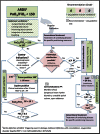S2e guideline: positioning and early mobilisation in prophylaxis or therapy of pulmonary disorders : Revision 2015: S2e guideline of the German Society of Anaesthesiology and Intensive Care Medicine (DGAI)
- PMID: 26335630
- PMCID: PMC4712230
- DOI: 10.1007/s00101-015-0071-1
S2e guideline: positioning and early mobilisation in prophylaxis or therapy of pulmonary disorders : Revision 2015: S2e guideline of the German Society of Anaesthesiology and Intensive Care Medicine (DGAI)
Abstract
The German Society of Anesthesiology and Intensive Care Medicine (DGAI) commissioneda revision of the S2 guidelines on "positioning therapy for prophylaxis or therapy of pulmonary function disorders" from 2008. Because of the increasing clinical and scientificrelevance the guidelines were extended to include the issue of "early mobilization"and the following main topics are therefore included: use of positioning therapy and earlymobilization for prophylaxis and therapy of pulmonary function disorders, undesired effects and complications of positioning therapy and early mobilization as well as practical aspects of the use of positioning therapy and early mobilization. These guidelines are the result of a systematic literature search and the subsequent critical evaluation of the evidence with scientific methods. The methodological approach for the process of development of the guidelines followed the requirements of evidence-based medicine, as defined as the standard by the Association of the Scientific Medical Societies in Germany. Recently published articles after 2005 were examined with respect to positioning therapy and the recently accepted aspect of early mobilization incorporates all literature published up to June 2014.
Durch die Deutsche Gesellschaft für Anästhesiologie und Intensivmedizin (DGAI) wurde der Auftrag erteilt, die seit 2008 bestehende S2-Leitlinie „Lagerungstherapie zur Prophylaxe oder Therapie von pulmonalen Funktionsstörungen“ zu revidieren. Aufgrund zunehmender klinischer und wissenschaftlicher Relevanz wurde die Leitlinie um den Themenkomplex „Frühmobilisation“ erweitert. Damit bezieht sie sich auf folgende thematische Schwerpunkte: Einsatz von Lagerungstherapie und Frühmobilisation zur Prophylaxe pulmonalerFunktionsstörungen, Einsatz von Lagerungstherapie und Frühmobilisation zur Therapie pulmonaler Funktionsstörungen, unerwünschte Wirkungen und Komplikationen von Lagerungstherapie und Frühmobilisation sowie praktische Aspekte beim Einsatz von Lagerungstherapie und Frühmobilisation. Diese Leitlinie ist das Ergebnis einersystematischen Literaturrecherche sowie der anschließenden kritischen Evidenzbewertungmit wissenschaftlichen Methoden. Das methodische Vorgehen des Leitlinienentwicklungsprozesses entspricht den Anforderungen an die evidenzbasierte Medizin, wie sie von der Arbeitsgemeinschaft der Wissenschaftlichen Medizinischen Fachgesellschaften als Standard definiert wurden. Bezüglich der Lagerungstherapie wurden neu publizierte Arbeiten ab 2005 untersucht; der neu aufgenommene Aspekt der Frühmobilisation umfasst die gesamte bisher publizierte Literatur bis einschließlich 06/2014. Der vorliegende Beitrag gibt die Kurzversion der Leitlinie wieder.
Keywords: backrest elevation; continuous lateral rotation; early mobilisation; positioning therapy; prone position; pulmonary disorder.
Figures


References
-
- Abroug F, Ouanes-Besbes L, Elatrous S, et al. The effect of prone positioning in acute respiratory distress syndrome or acute lung injury: a meta-analysis. Areas of uncertainty and recommendations for research. Intensive Care Med. 2008;34:1002–1011. - PubMed
-
- Ahrens T, Kollef M, Stewart J, et al. Effect of kinetic therapy on pulmonary complications. Am J Crit Care. 2004;13(5):376–383. - PubMed
-
- Albert RK, Hubmayr RD. The prone position eliminates compression of the lungs by the heart. Am J Respir Crit Care Med. 2000;161:1660–1665. - PubMed
Publication types
MeSH terms
LinkOut - more resources
Full Text Sources
Other Literature Sources
Medical

